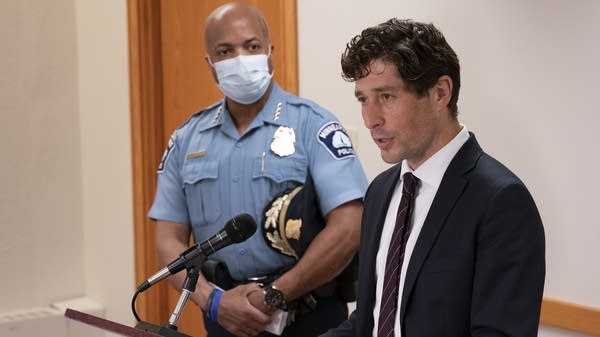Minneapolis officials announce changes aimed at reducing police use of force incidents

Go Deeper.
Create an account or log in to save stories.
Like this?
Thanks for liking this story! We have added it to a list of your favorite stories.
Updated at 5:20 p.m.
Minneapolis officers will be barred from shooting at moving vehicles unless safety is an issue, and will have to provide explanations every time they unholster weapons, the city’s mayor and police chief announced Wednesday.
Mayor Jacob Frey and Police Chief Medaria Arradondo said the changes are part of a policy overhaul designed at improving trust after the killing of George Floyd in May, in addition to previous incidents over the years.
“We have an opportunity that has eluded previous administrations,” Frey said at a news conference announcing the changes.
He said the policy changes do not require approval by the officers’ union, the Police Officers Federation of Minneapolis.
Turn Up Your Support
MPR News helps you turn down the noise and build shared understanding. Turn up your support for this public resource and keep trusted journalism accessible to all.
The policy changes go into effect Sept. 8. Arradondo said some training will be provided in person and via video, taking into account COVID-19 restrictions.
Officers “want to give their best” for the community and their resilience is being tested, Arradondo said, adding that Minneapolis residents still want reform.
"What I have heard from communities over the course of several years is the impact when officers point their weapons at them, even if it doesn't result in an arrest situation, the trauma that that can have,” said Arradondo. “And as the mayor very validly noted, that's a threatening use of force, and we had not captured that ever before."
Frey said that even though he does not believe the union needs to sign off on the changes, he has notified the group and has sent them to Minnesota’s POST Board.
A statement from the union says it was caught off guard by the announcement.
“We are working to review what all this entails, but believe it is careless to announce changes to a critical policy to the media before releasing to officers — and training them — to implement the changes,” according to the statement.
The mayor reiterated that the laws around arbitration limit what city officials may do to respond to misconduct by officers.
The new policy is also aimed at police conduct that outraged many who saw the video of Floyd pinned to the ground while handcuffed by three officers, while a fourth stood by. Any use of force against someone who’s handcuffed is subject to a higher standard of what’s considered reasonable.
The rules also require someone put into a hobble restraint, straps that go around a person’s feet and waist, to be placed on their side. And if officers suspect the arrestee has a medical condition, they must notify paramedics or take the person to a hospital.
Deadly force remains permissible if an officer reasonably believes that a person will cause death or great bodily harm to another. In line with the new police reform law that Minnesota legislators passed this summer, law enforcement must to consider all reasonable alternatives including so-called “less lethal” measures before using deadly force.
The rules also include more explicit definitions of what constitutes resistance to police, and requires officers to use the minimal amount of force necessary to gain compliance. This ranges from passive resistance such as going limp or locking arms with a fellow protester all the way to what’s called “aggravated aggressive resistance,” including using a gun or a knife. Officers would be held accountable for using a disproportionate amount of force.
Civil rights attorney Nekima Levy Armstrong said the new policy will raise expectations for officers. She agrees that officers must justify and document each time they unholster their weapon. Levy Armstrong says that when former Minneapolis police officer Thomas Lane pointed his gun at George Floyd, the situation escalated immediately and Floyd feared for his life. But Levy Armstrong said the policy is only as good as those implementing and enforcing it.
“There needs to be some public oversight and accountability to ensure that the documentation is being followed up on in terms of transparency and accountability,” Levy Armstrong said.
She said when citizens file complaints about excessive force, department supervisors need to look at those complaints and match what’s there to the new documentation that officers will be required to file.
In June, Minneapolis police stopped allowing officers to view body camera footage in use of force incidents to help them write their reports. Civilians who were witnesses to the same incidents were not allowed to view the footage before giving statements to investigators.


